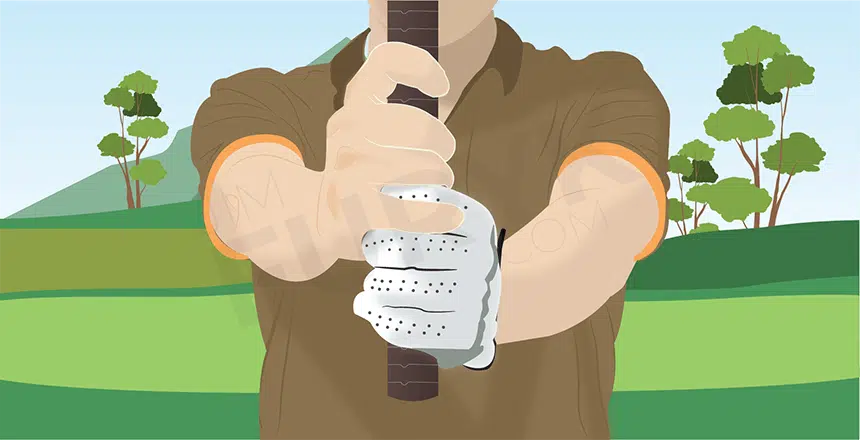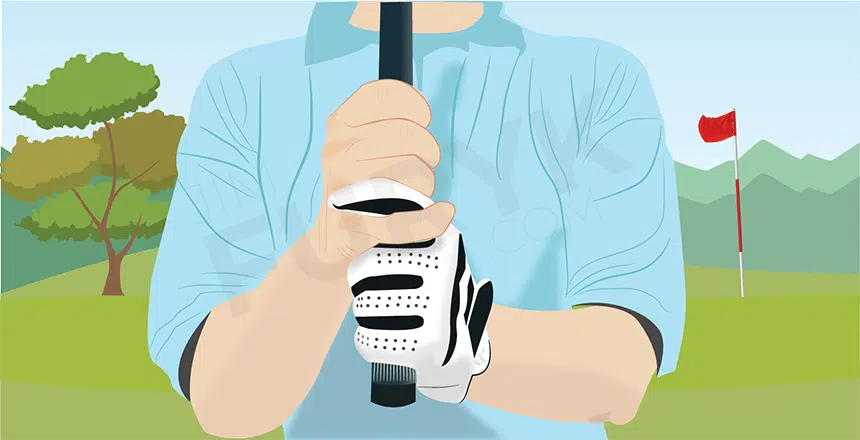There’s the more common interlock grip that many golfers prefer over the overlap version. And then there’s also a third type of grip, known as the baseball or hammer grip, which normally beginners rely on. Although it’s not the best if you want to level up in golf. So let’s focus more on the overlapping vs interlocking golf grip comparison.
Overlapping and interlocking are the two most popular ways to grip, even though they don’t form as naturally as their baseball counterpart. But once you know how to properly grip your golf club using either of the two or both, you can expect your game and its pace of play to improve.
And to be honest, talking about the grip being a crucial aspect, since it’s the only thing that connects you to your club during the whole golf swing sequence, is old news as I’ve already done that in this complete guide for mastering the correct golf grip. Instead, how about we compare the two different, most common types of gripping techniques?
In This Post
Overlap Golf Grip Explained (with pros and cons)

Overlapping (also called the Vardon grip) implies taking the pinky finger of your right hand and placing it at the top between the middle and index fingers of your left hand. It works like a charm for those with bigger-than-normal hands. And even for controlling how much grip pressure you exert.
With the overlapping method, releasing the club feels slightly easier. Plus, you also experience less irritation in the hands, and the chances of blisters developing decreases as well.
Popular golfers like Arnold Palmer, Ben Hogan, and Phil Mickelson use the overlapping grip. So, in a way, you can label it as a more Tour-level golf grip.
OVERLAPPING GOLF GRIP BENEFITS
- Feels More Comfortable
A high comfort level matters here with your golf grip because it leads to producing a more flawless, smoother swing.
In comparison to this, the other gripping methods tend to create lots of hand or wrist tension. Thus, reducing clubhead speed as well as minimizing your distance potential (and who wants that!).
- Works the Best for Larger Hands
If you got large hands, overlapping those to form your golf grip is the correct way to go about it. This technique unites your hands together, meaning it forms a solid, single unit, while also enabling greater wrist freedom. And you know what that means, don’t you?
With all that wrist freedom, you can boost power, speed, and distance (mainly for your off-the-tee shots).
CONS OF THE OVERLAPPING GOLF GRIP
- Not Enough Control for Small Hands
Lack of control is what you get with the overlap grip if you have smaller hands. It’s as simple as that.
- Excessive Wrist Freedom
While it’s necessary and beneficial to have wrist freedom to be able to hit longer, there’s a fine line between that and too much freedom in the wrists. In the case of the latter, which is often a problem with golfers who have really, really strong hands, over-rotating or over-using the wrists for increasing distance potential becomes inevitable.
So rather than initiating a smooth golf swing, you end up whipping that club through that hitting zone. Hence, generating inaccurate, wayward shots off the tee. At such times then, you should consider switching to the interlock grip for counterbalancing your too strong or overactive hands.
Interlock Golf Grip Explained (with pros and cons)

Now this one requires you to place your right pinky through and between your left hand’s middle finger and index finger, and not at the top like the overlapping grip. It’s the most suitable for smaller hands since the grip offers more control because your hands feel like they’re working together.
Just avoid gripping the golf club with too much pressure. Otherwise, interlocking will feel funny as well as create some friction between your fingers. But when done right, the interlock grip can build a single, solid foundation, which is something that Tour players like Tiger Woods and Jack Nicklaus definitely seem to appreciate.
Now it’s time for the interlocking golf grip pros and cons…
INTERLOCKING GOLF GRIP BENEFITS
- Creates A Locked Physical Connection
This locked-together physical bond takes place between all your fingers in use during the gripping action, which ensures that both your hands are pulled together tightly. As a result, physical strength, thanks to that very strong connection between your two hands, increases. And the advantages of this can take form in many, many ways.
- Creates Unity
Your hands should feel united at the time of gripping the golf club. And this is very important if you don’t want each wrist to act separately instead of working together like a hinge.
So when you choose the interlock grip style, you don’t have to worry about your wrists or hands interfering with one another. The gripping technique itself pulls your hands together, thus leaving no gaps i.e. room for error between the fingers.
- Forms Natural Strength
Just ask Jack Nicklaus and he’ll explain clearly how the interlock golf grip is the most fitting for weaker hands. After all, this grip does lock into place the club using interlocked hands/fingers without expending any extra or unnecessary pressure or effort.
And even if you have stronger hands, this grip creates a firm base to work with, without any excessive hand or forearm tension. Hence, your muscles, in these crucial moments, remain relaxed. And that, in turn, during the swing produces greater clubhead speed while also prioritizing more golf club control.
- Most Suitable for Smaller Hands
If Jack Nicklaus and Tiger Woods used the interlocking grip, does that mean they had comparatively smaller hands? Yes, they did. And that’s precisely why the interlock method allowed them to form a better, more secure grip.
With interlock, all your fingers stay close to the golf club’s cushioned grip. The interlocked fingers themselves don’t create any large gaps below.
CONS OF THE INTERLOCKING GOLF GRIP
- Not the best for golfers with larger hands.
- Reduced wrist action, thus reduced power.
- Feels quite unnatural if you’re a beginner.
- The grip relies more on accuracy and power, hence it can intensify any posture and/or swing-related problems.
Which Golf Grip Is Better Then, Overlap or Interlock?
It depends from player to player. Meaning you choose between overlap and interlock based on which golf grip feels more comfortable in that it lets the hands sit neutrally on your club.
The whole idea is to be able to release that golf club while also remaining connected through the entire swing sequence.
However, in the majority of situations, golfers who have larger hands opt for the overlap type of golf grip while those with relatively smaller hands use the interlocking technique. So, honestly, there’s no direct or right answer to which of the two grips is better.
Differences Between Overlap Grip and Interlock Grip
The overlap grip may be more popular these days but it’s the interlocking method that ranks as the more traditional approach. Whatever side you seem to be on, there’s no doubt that both grips offer their own pros and cons.
Short and simple – the primary difference between these two golf grips is the positioning of the right pinky finger. With overlap, this finger is placed between the left hand’s middle and index fingers, at the top.
But with interlock, the right pinky goes through and between the middle finger and index finger of your left hand. In this case, your two hands are locked together across all points of the swing. So it surely is more advantageous in terms of having more control over your club.
On the other hand, the overlap grip style is better when it comes to releasing your hands more easily during impact (anti-fade performance). Or if you have larger hands.
Which Golf Grip Do Most Pro or Tour Golfers Use?
If you take a look at PGA Tour players, you’ll notice that most of them go for the overlapping version (Arnold Palmer, Ben Hogan, Phil Mickelson, and more). For the simple reason that this particular golf grip brings those wrists closer together, which compels them to work as one single unit. Thus, more wrist freedom to drive at greater speed and distance.
Who Uses the Interlocking Grip?
Tiger Woods, Rory McIlroy, and Jack Nicklaus prefer the interlock grip method, despite being Tour players, because of their comparatively smaller hands. With this grip, it becomes easier to enhance control, no matter your smaller hands, throughout the golf swing.
What Is the Baseball Golf Grip?
Also known as the ten-finger or hammer grip, the baseball grip in golf involves the use of all your 10 fingers. Just how you used to grip a baseball when you were younger or still do!
This ten-finger or baseball grip is common among junior and beginner golfers. And then once they transition from the lower levels of golf to the higher ones, they make the switch to either overlap or interlock. Otherwise, improvements in golf are not possible. After all, the baseball grip style doesn’t force the hands to work as a single unit.
And when your hands don’t work together, excessive hand action tends to interfere with the golf swing, thus leading to a too-tight grip pressure and inaccurate, erratic shots.
But then those who find overlapping or interlocking the hands painful, which mainly happens with senior golfers, it’s completely okay to use the ten-finger approach. Just avoid exerting too much grip pressure!
What Is the Best Grip for Putting?
Just as putter length is nothing like the standard shaft length of other golf clubs, the putter grip differs too. It can and should be one out of these three putting grip types – cross-hand, claw (more popular among pros), and reverse overlap (more suitable and comfortable for amateur golfers because of the combination of speed and feel).
As for the aim with putting, your goal ought to be to get the hands out. And the bigger the muscles you have, the more putting consistency you can achieve.
For Creating A Draw, Should You Use Overlap or Interlock Grip?
It’s the overlapping grip style that paves the way for easier golf club release. Therefore, also easier for drawing your shots. At the release moment, the clubface can open, square, and then close. And this final closed position of the clubface is what hits a draw.
So if you have major or even the slightest fading/slicing tendencies, choose the overlap grip instead of interlock.
Final Words – How to Tell If You’re Using the Best Grip for Your Game?
Honestly, you’ll only know once you experiment with different methods of gripping. Generally, beginners and/or those with large hands select the overlapping golf grip. But then if your hands are comparatively smaller, irrespective of whether you’re a beginner or pro, always pick the interlock grip.
The whole aim is to use a grip that feels comfortable, maybe not at first but eventually at least. You should be positioning those precious hands of yours on the golf club in the same manner each time instead of fidgeting with or adjusting the grip.
So there’s no direct or right answer to which grip is better, rather it all depends on your golfing skills and what you’re comfortable with as well as the size of your hands.

